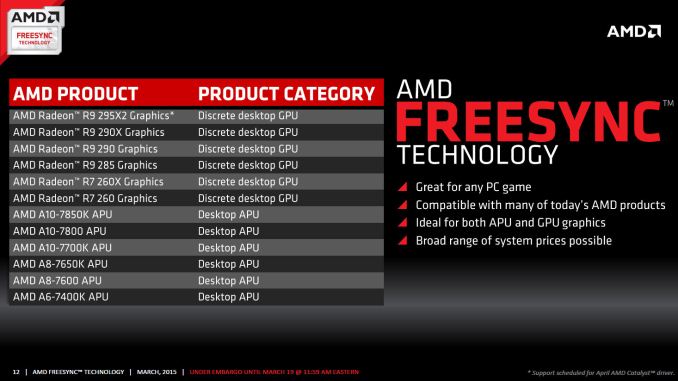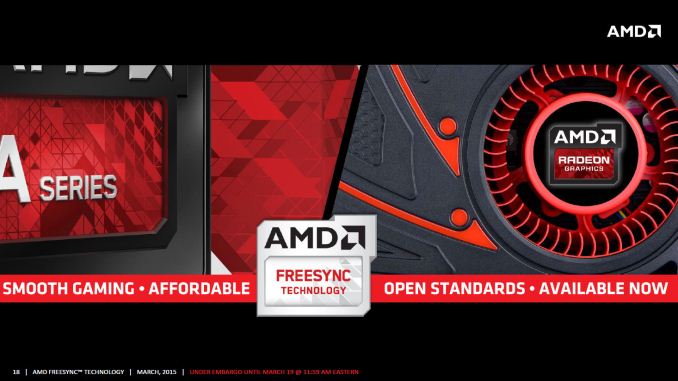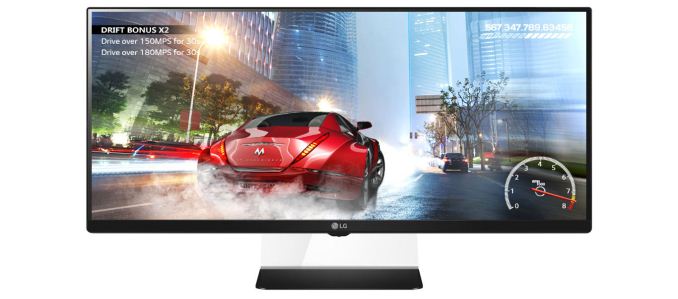The AMD FreeSync Review
by Jarred Walton on March 19, 2015 12:00 PM ESTClosing Thoughts
It took a while to get here, but if the proof is in the eating of the pudding, FreeSync tastes just as good as G-SYNC when it comes to adaptive refresh rates. Within the supported refresh rate range, I found nothing to complain about. Perhaps more importantly, while you’re not getting a “free” monitor upgrade, the current prices of the FreeSync displays are very close to what you’d pay for an equivalent display that doesn’t have adaptive sync. That’s great news, and with the major scaler manufacturers on board with adaptive sync the price disparity should only shrink over time.
The short summary is that FreeSync works just as you’d expect, and at least in our limited testing so far there have been no problems. Which isn’t to say that FreeSync will work with every possible AMD setup right now. As noted last month, the initial FreeSync driver that AMD provided (Catalyst 15.3 Beta 1) only allows FreeSync to work with single GPU configurations. Another driver should be coming next month that will support FreeSync with CrossFire setups.
Besides needing a driver and FreeSync display, you also need a GPU that uses AMD’s GCN 1.1 or later architecture. The list at present consists of the R7 260/260X, R9 285, R9 290/290X/295X2 discrete GPUs, as well as the Kaveri APUs – A6-7400K, A8-7600/7650K, and A10-7700K/7800/7850K. First generation GCN 1.0 cards (HD 7950/7970 or R9 280/280X and similar) are not supported.
All is not sunshine and roses, however. Part of the problem with reviewing something like FreeSync is that we're inherently tied to the hardware we receive, in this case the LG 34UM67 display. Armed with an R9 290X and running at the native resolution, the vast majority of games will run at 48FPS or above even at maximum detail settings, though of course there are exceptions. This means they look and feel smooth. But what happens with more demanding games or with lower performance GPUs? If you're running without VSYNC, you'd get tearing below 48FPS, while with VSYNC you'd get stuttering.
Neither is ideal, but how much this impacts your experience will depend on the game and individual. G-SYNC handles dropping below the minimum FPS more gracefully than FreeSync, though if you're routinely falling below the minimum FreeSync refresh rate we'd argue that you should lower the settings. Mostly what you get with FreeSync/G-SYNC is the ability to have smooth gaming at 40-60 FPS and not just 60+ FPS.
Other sites are reporting ghosting on FreeSync displays, but that's not inherent to the technology. Rather, it's a display specific problem (just as the amount of ghosting on normal LCDs is display specific). Using higher quality panels and hardware designed to reduce/eliminate ghosting is the solution. The FreeSync displays so far appear to not have the same level of anti-ghosting as the currently available G-SYNC panels, which is unfortunate if true. (Note that we've only looked at the LG 34UM67, so we can't report on all the FreeSync displays.) Again, ghosting shouldn't be a FreeSync issue so much as a panel/scaler/firmware problem, so we'll hold off on further commentary until we get to the monitor reviews.
One final topic to address is something that has become more noticeable to me over the past few months. While G-SYNC/FreeSync can make a big difference when frame rates are in the 40~75 FPS range, as you go beyond that point the benefits are a lot less clear. Take the 144Hz ASUS ROG Swift as an example. Even with G-SYNC disabled, the 144Hz refresh rate makes tearing rather difficult to spot, at least in my experience. Considering pixel response times for LCDs are not instantaneous and combine that with the way our human eyes and brain process the world and for all the hype I still think having high refresh rates with VSYNC disabled gets you 98% of the way to the goal of smooth gaming with no noticeable visual artifacts (at least for those of us without superhuman eyesight).
Overall, I’m impressed with what AMD has delivered so far with FreeSync. AMD gamers in particular will want to keep an eye on the new and upcoming FreeSync displays. They may not be the “must have” upgrade right now, but if you’re in the market and the price premium is less than $50, why not get FreeSync? On the other hand, for NVIDIA users things just got more complicated. Assuming you haven’t already jumped on the G-SYNC train, there’s now this question of whether or not NVIDIA will support non-G-SYNC displays that implement DisplayPort’s Adaptive Sync technology. I have little doubt that NVIDIA can support FreeSync panels, but whether they will support them is far less certain. Given the current price premium on G-SYNC displays, it’s probably a good time to sit back and wait a few months to see how things develop.
There is one G-SYNC display that I’m still waiting to see, however: Acer’s 27” 1440p144 IPS (AHVA) XB270HU. It was teased at CES and it could very well be the holy grail of displays. It’s scheduled to launch next month, and official pricing is $799 (with some pre-orders now online at higher prices). We might see a FreeSync variant of the XB270HU as well in the coming months, if not from Acer than likely from some other manufacturer. For those that work with images and movies as well as playing games, IPS/AHVA displays with G-SYNC or FreeSync support are definitely needed.
Wrapping up, if you haven’t upgraded your display in a while, now is a good time to take stock of the various options. IPS and other wide viewing angle displays have come down quite a bit in pricing, and there are overclockable 27” and 30” IPS displays that don’t cost much at all. Unfortunately, if you want a guaranteed high refresh rate, there’s a good chance you’re going to have to settle for TN. The new UltraWide LG displays with 75Hz IPS panels at least deliver a moderate improvement though, and they now come with FreeSync as an added bonus.
Considering a good display can last 5+ years, making a larger investment isn’t a bad idea, but by the same token rushing into a new display isn’t advisable either as you don't want to end up stuck with a "lemon" or a dead technology. Take some time, read the reviews, and then find the display that you will be happy to use for the next half decade. At least by then we should have a better idea of which display technologies will stick around.













350 Comments
View All Comments
SleepModezZ - Thursday, March 19, 2015 - link
Really different reviews between AnandTech and PC Perspective. You conclude that FreeSync performs as well as G-Sync - if not better, because of the option to disable V-sync. PC Perspective, on the other hand, noticed that their FreeSync monitors performed badly compared to the G-Sync monitors when the frame rate dropped below the lowest refresh rate of the monitor.You give the impression that they would behave the same - or FreeSync would be potentially better because you could choose your poison: stutter or tearing - when with G-Sync you would always get stuttering. PC Perspective, on the other hand, tells that G-Sync monitors handle this gracefully by refreshing the display twice or more during those longer frames - and as such G-Sync avoids both stutter and tearing at those lower fram rates. Their FreeSync monitors did not do that - and the stuttering or tearing was very noticeable. The frame rate dropping below 48 fps is not uncommon and the displays behavior in those situations is very important. That makes the G-Sync the superior technology. Unless - the tearing or stuttering at speeds lower than the display's lowest refresh rate is only a problem with that specific monitor and not with the FreeSync / AdaptiveSync technology in general. (The LG monitor is incapable of doubling its slowest refresh rate - other monitors that are capable maybe could handle the situation differently. If not, FreeSync is the inferior technology.)
I don't know how G-Sync and FreeSync actually would handle full screen movies at 24 fps. G-Sync could easily display it at a 48 Hz refresh rate. Your LG monitor would probably also show it at 48 Hz - because it is the lowest it could go. But would the LG monitor with FreeSync be smart enough to show a 25 fps movie in 50 Hz - or would it display it in 48 Hz with unnecessary tearing or stuttering?
Gigaplex - Friday, March 20, 2015 - link
"PC Perspective, on the other hand, tells that G-Sync monitors handle this gracefully by refreshing the display twice or more during those longer frames - and as such G-Sync avoids both stutter and tearing at those lower fram rates."That would drastically reduce the effects of tearing, but it would not do much, if anything, for stutter.
SleepModezZ - Friday, March 20, 2015 - link
It would reduce stutter in the sense that if the frame rate were, for example, constantly 30 fps, G-sync would give you every frame when it is ready - keeping the motion fluid. FreeSync with V-SYnc on, on the other hand, would force that into the lowest refresh rate of the monitor. It would double some frames and not others - making the timing of the frames different and making a constant 30 fps motion jerky where G-Sync would not. I would call that jerky motion 'stutter' - FreeSync (currently) has it, G-Sync does not.In short, G-Sync retains its variable refresh rate technology when going under the displays min refresh rate. FreeSync does not but switches to constant refresh rate at the monitors min refresh rate - introducing either tearing or stutter. Within the display's refresh rate range they perform the same. When going faster than the refresh rate range - FreeSync gives the option of disabling V-Sync and choosing tearing instead of stuttering. There it is better. I just think that the low fps range is probably more important than the high. I would not buy any FreeSync / Adaptive Sync displays before they demonstrate that they can handle those low fps situations as gracefully as G-Sync does.
WatcherCK - Thursday, March 19, 2015 - link
TFTcentral have done a review of the soon to be released Acer monitor:http://www.tftcentral.co.uk/reviews/acer_xb270hu.h...
And as Ryan said it is a beast, but one question you buy an XB270hu and you plug in your 290x, because the video card doesnt support GSYNC uses the standard scaler? in the Acer to display video data. Now if the Acer uses a scaler from one of the four main manufacturers listed in the article is there a chance it would support Freesync? (Acer wouldnt advertise that obviously since the monitor is a GSYNC branded monitor....)
So there are a few assumptions above about the operations of GSYNC, but Im curious if this will be the case as it keeps red and green camps happy...
One other question if anyone is happy to answer, high hertz refresh monitors will they maintain their peak capable refresh when in portrait mode or are they limited to a lower refresh rate or GSYNC for that matter? Im thinking a triple monitor portrait setup for my next build.
cheers
sonicmerlin - Thursday, March 19, 2015 - link
Will Freesync work with the current gen consoles?SleepModezZ - Thursday, March 19, 2015 - link
No.Adaptive Sync is a Display Port specific standard. What current gen console supports Display Port? None to my knowledge. HDMI is a different standard and I don't think there have been even any rumors about putting adaptive sync technology into the HDMI standard. And if it some day would come - would the current HDMI hardware on the consoles be able to support it after a driver update from AMD? Probably not.
Murloc - Thursday, March 19, 2015 - link
it's not likely to happen any time soon since video and STBs etc. revolve around the usual framerates and TVs do the same so there's no need for this kind of flexibility, tearing is not an issue.Too bad that TV standards like HDMI spill over in the computer world (audio, projectors, laptops, etc.) and hamstring progress.
sonicmerlin - Friday, March 20, 2015 - link
Well what if MS and Sony released hardware refreshes (like a slimmed down PS4) that included display port?Gigaplex - Friday, March 20, 2015 - link
I'm pretty sure that both Xbox One and PS4 use GCN 1.0 hardware, so no, a DisplayPort refresh probably wouldn't help.Norseman4 - Thursday, March 19, 2015 - link
Can you please verify some information:On the specs page for the BenQ XL2730Z (http://gaming.benq.com/gaming-monitor/xl2730z/spec... it states a 54Hz min vertical refresh. This could be a copy/paste issue since it's the same as the min horizontal refresh.